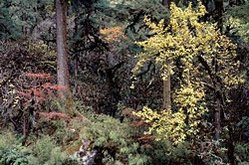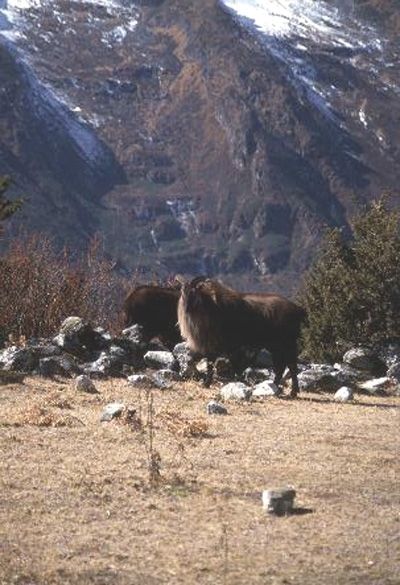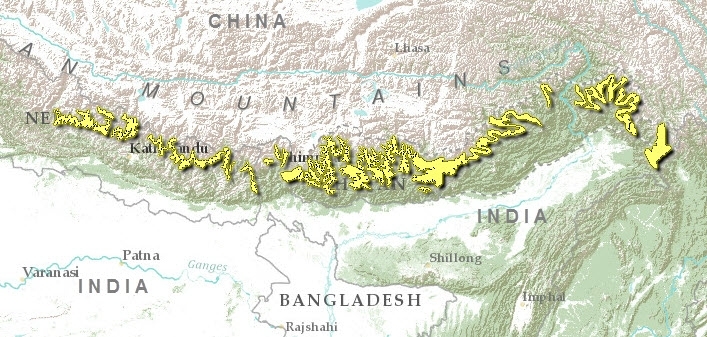Eastern Himalayan subalpine conifer forests
The Eastern Himalayan Sub-Alpine Conifer Forests represent the transition from the forested ecoregions of the Himalayas to treeless alpine meadows and boulder-strewn alpine screes. Their ecological role within the interconnected Himalayan ecosystem, which extends from the alluvial grasslands along the foothills to the high alpine meadows, makes the forests of this ecoregion a conservation priority. Conservation of the Himalayan biodiversity is contingent on protecting the interconnected processes among the Himalayan ecosystems. For instance, several Himalayan birds and mammals exhibit altitudinal seasonal migrations and depend on contiguous habitats that permit these movements. The integrity of the watersheds of the rivers that originate in the high mountains of this majestic range depends on the intactness of habitat, from the high elevations to the lowlands. If any of the habitat layers are lost or degraded, these processes will also be disrupted.
The ecoregion straddles the transition from the southern Indo-Malayan to the northern Palearctic fauna. Here tigers yield to snow leopards, and sambar are replaced by blue sheep. But the ecoregion also has its own specialized flora and fauna, such as the musk deer and red panda, which are limited to these mature temperate conifer forests.
Location and General Description
The ecoregion represents the belt of conifer forest between 3,000 and 4,000 meters, from east of the Kali Gandaki River in Nepal through Bhutan and into the state of Arunachal Pradesh, in India. These forests usually are confined to the steeper, rocky, north-facing slopes and therefore are inaccessible to human habitation and cultivation.
The ecoregion has recent origins. The Himalayas were born of the tumultuous collision between the northward-drifting Deccan Plate and the Eurasian continent during the Cretaceous. The Himalayas were created during this and three subsequent periods of geologic upheaval and uplift.
Today, the Himalayan Mountain Range comprises three east-west-directed parallel zones. The southernmost is the outer Himalayas, also known as the Siwaliks, which lies adjacent to the Indo-Gangetic Plain. The Middle Himalayas represent a series of ridges and valleys that rise to about 5,000 meters and contain this ecoregion. The Inner Himalayas are where the imposing, giant peaks such as Everest, Makalu, and Dhaulagiri tower far above the Deccan Plateau.
 Kanchanjunga Conservation Area, Nepal. (Photograph by Chris Carpenter) The Himalayas capture moisture from the monsoons that sweep in from the Bay of Bengal. Therefore, the eastern Himalayas, being closer to the source, receive more precipitation than the western Himalayas. This trend is reflected in the timberline, which declines from 4,500 meters in the east to about 3,600 meters in the west.
Kanchanjunga Conservation Area, Nepal. (Photograph by Chris Carpenter) The Himalayas capture moisture from the monsoons that sweep in from the Bay of Bengal. Therefore, the eastern Himalayas, being closer to the source, receive more precipitation than the western Himalayas. This trend is reflected in the timberline, which declines from 4,500 meters in the east to about 3,600 meters in the west.
These temperate conifer forests are dominated by fir (Abies spectabilis), larch (Larix griffithii), hemlock (Tsuga dumosa), Juniperus recurva, and Juniperus indica. Several colorful rhododendrons (Rhododendron hodgsonii, R. barbatum, R. campylocarpum, R. campanulatum, R. fulgens, R. thomsonii) grow profusely in the understory, along with Viburnum grandiflorum, Lonicera angustifolia, Betula utilis, Acer spp., Sorbus spp., Juniperus indica, and J. recurva. There is considerable species turnover among the rhododendrons along the east-west axis. Species common in central Nepal can be absent from the community in eastern Bhutan. This contributes to the overall diversity of the ecoregion.
Between 2,500 and 3,000 meters, the wetter areas are dominated by Tsuga dumosa, which also forms mixed stands with fir. Blue pine (Pinus wallichiana) occurs in the drier inner valleys closer to Tibet. Blue pine is especially common in the Khumbu region, where it forms a distinct community. Patches of pure birch (Betula utilis) represent a pioneer stage that climaxes as a Betula-Abies mixed forest. Taxus baccata is an important, uncommon species in this forest community.
Juniper woodland is another distinct habitat type within this sub-alpine conifer zone. It characteristically grows along the flat, inner river valleys with willow (Salix spp.) and Prunus spp. The juniper woodlands in Tsarijathang, in Jigme Dorji National Park, Bhutan, in particular are used by takin (Budorcas taxicolor) as summer habitat.
Biodiversity Features
Overall, the mammal fauna consists of eighty-nine species. The ecoregion lies within the ecotone between the Indo-Malayan and Palearctic zoogeographic zones. Therefore, the mammal fauna from both zones, such as civets, martens, Himalayan tahr, and muntjac are included within the ecoregion. Three species-two squirrels and a murid rodent-with limited distributions are considered to be endemic to the ecoregion (Table 1). Whereas the squirrels are near-endemic species that are shared with neighboring ecoregions, Apodemus gurkha is a strict endemic that has been recorded only from this ecoregion.
|
Table 1. Endemic and Near-Endemic Mammal Species. Family Species Sciuridae Petaurista magnificus Sciuridae Petaurista nobilis Apodemus Apodemus gurkha* An asterisk signifies that the species' range is limited to this ecoregion. Although not endemic species, the red panda and the Himalayan musk deer (Moschus chrysogaster) are characteristic of the mature fir forests represented by this ecoregion (Eastern Himalayan subalpine conifer forests) . The red pandas usually are limited to Abies-ringal bamboo forests between 3,000 and 4,000 meters, where precipitation is high. The musk deer is widely hunted for its musk glands, which allegedly have pharmaceutical properties. The waxy, brown musk (a single musk gland yields about 25 grams of musk) can fetch as much as US$45,000 per kilogram on the international market. The ecoregion harbors several threatened species, including the endangered red panda (Ailurus fulgens), takin (Budorcas taxicolor), serow (Capricornis sumatraensis), and particolored squirrel (Hylopetes alboniger). The endangered tiger (Panthera tigris) roams the broadleaf forests lower down and occasionally ventures into these conifer forests. But the prey base in the conifer forests is insufficient to harbor a viable resident population within this ecoregion. In addition to these endangered species, the following species are considered vulnerable and should also receive conservation attention: the Vespertilionidae bat Myotis sicarius, wild dog (Cuon alpinus), Asiatic black bear (Ursus thibetanus), and Himalayan tahr (Hemitragus jemlahicus). There are more than 200 species of birds known to this ecoregion, of which six are considered endemic to the ecoregion (Table 2). |
|---|

